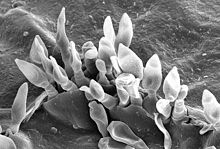Dothideomycetes
| Dothideomycetes | |
|---|---|

| |
| The reproductive conidia of Venturia inaequalis erupting through the cuticle of a crabapple leaf | |
| Scientific classification | |
| Domain: | Eukaryota |
| Kingdom: | Fungi |
| Division: | Ascomycota |
| Subdivision: | Pezizomycotina |
| (unranked): | Leotiomyceta |
| (unranked): | Dothideomyceta |
| Class: | Dothideomycetes O.E.Erikss. & Winka (1997) |
| Subclasses & orders | |
| |
Dothideomycetes is the largest and most diverse class of ascomycete fungi. It comprises 11 orders 90 families, 1,300 genera and over 19,000 known species.[1][2] Wijayawardene et al. in 2020 added more orders to the class.[3]
Traditionally, most of its members were included in the loculoascomycetes, which is not part of the currently accepted classification.[4] This indicates that several traditional morphological features in the class are not unique and DNA sequence comparisons are important to define the class.[5]
The designation loculoascomycetes was first proposed for all fungi which have ascolocular development.[6] This type of development refers to the way in which the sexual structure, bearing the sexual spores (ascospores) forms. Dothideomycetes mostly produce flask-like structures referred to as pseudothecia, although other shape variations do exist (e.g. see structures found in Hysteriales). During ascolocular development pockets (locules) form first within the vegetative cells of the fungus and then all the subsequent structures form. These include the asci which, superficially, have a thicker outer layer through which a thinner inner layer ‘bursts’, like a jack-in-a-box to release the spores. These asci are therefore referred to as bitunicate (superficially, two layers) or fissitunicate (referring to spore release). After several DNA sequence comparisons it is now clear that another group of fungi which share these characteristics are distantly related. These are the "black yeasts" in subclass Chaetothyriomycetidae (Eurotiomycetes).[7] This means that loculoascomycetes did not constitute a natural group.
The best known members of this class are several important plant pathogens (like Phaeosphaeria nodorum and Venturia inaequalis). However, a majority of described species are either found as endophytes or saprobes growing on woody debris, decaying leaves or dung. A smaller number exist as lichens[8] and a single species, Cenococcum geophilum, can form mycorrhizal associations with plant roots.[9]
See also
[edit]References
[edit]- ^ Kirk PM, Cannon PF, Minter DW, Stalpers JA (2008). Dictionary of the Fungi (10th ed.). Wallingford: CABI. p. 221. ISBN 978-0-85199-826-8.
- ^ Schoch CL, Crous PW, Groenewald JZS, Boehm EWA, Burgess TI, Gruyter J De, Hoog GS De, Dixon LJ, Grube M, Gueidan C, Harada Y, Hatakeyama S, Hirayama K, Hosoya T, Huhndorf SM, Hyde KD, Jones EBG, Kohlmeyer J, Kruys Å, Li YM, Lücking R, Lumbsch HT, Marvanová L, Mbatchou JS, McVay AH, Miller AN, Mugambi GK, Muggia L, Nelsen MP, Nelson P, Owensby CA, Phillips AJL, Phongpaichit S, Pointing SB, Pujade-Renaud V, Raja HA, Rivas Plata E, Robbertse B, Ruibal C, Sakayaroj J, Sano T, Selbmann L, Shearer CA, Shirouzu T, Slippers B, Suetrong S, Tanaka K, Volkmann-Kohlmeyer B, Wingfield MJ, Wood AR, Woudenberg JHC, Yonezawa H, Zhang Y, Spatafora JW (2009). "A class-wide phylogenetic assessment of Dothideomycetes" (PDF). Studies in Mycology. 64: 1–15. doi:10.3114/sim.2009.64.01. PMC 2816964. PMID 20169021. Archived from the original (PDF) on 2011-09-27. Retrieved 2010-02-04.
- ^ Wijayawardene, Nalin; Hyde, Kevin; Al-Ani, Laith Khalil Tawfeeq; Somayeh, Dolatabadi; Stadler, Marc; Haelewaters, Danny; et al. (2020). "Outline of Fungi and fungus-like taxa". Mycosphere. 11: 1060–1456. doi:10.5943/mycosphere/11/1/8. hdl:10481/61998.
- ^ Hibbett DS, Bidenra M, Bischoff JF, Blackwell M, Cannon PF, Eriksson OE, Huhndorf S, James T, Kirk PM, Lücking R, Lumbsch T, Lutzoni F, Matheny PB, Mclaughlin DJ, Powell MJ, Redhead S, Schoch CL, Spatafora JW, Stalpers JA, Vilgalys R, Aime MC, Aptroot A, Bauer R, Begerow D, Benny GL, Castlebury LA, Crous PW, Dai Y-C, Gams W, Geiser DM, Griffith GW, Gueidan C, Hawksworth DL, Hestmark G, Hosaka K, Humber RA, Hyde K, Ironside JE, Koljalg U, Kurtzman CP, Larsson K-H, Lichtwardt R, Longcore J, Miadlikowska J, Miller A, Moncalvo J-M, Mozley-Standridge S, Oberwinkler F, Parmasto E, Reeb V, Rogers JD, Roux C, Ryvarden L, Sampaio JP, Schüßler A, Sugiyama J, Thorn RG, Tibell L, Untereiner WA, Walker C, Wang Z, Weir A, Weiß M, White MM, Winka K, Yao Y-J, Zhang N (2007). "A higher-level phylogenetic classification of the Fungi". Mycological Research. 111 (Pt 5): 509–47. CiteSeerX 10.1.1.626.9582. doi:10.1016/j.mycres.2007.03.004. PMID 17572334.
- ^ Lumbsch HT, Huhndorf S (2007). "Whatever happened to the pyrenomycetes and loculoascomycetes?". Mycological Research. 111 (Pt 9): 1064–1074. doi:10.1016/j.mycres.2007.04.004. PMID 18029164.
- ^ Luttrell ES, 1951. Taxonomy of Pyrenomycetes. University of Missouri Studies 24, 1–120.
- ^ Geiser, DM; Gueidan, C; Miadlikowska, J; Lutzoni, F; Kauff, F; Hofstetter, V; Fraker, E; Schoch, CL; Tibell, L; et al. (2006). "Eurotiomycetes: Eurotiomycetidae and Chaetothyriomycetidae". Mycologia. 98 (6): 1053–1064. doi:10.3852/mycologia.98.6.1053. PMID 17486980.
- ^ Nelsen MP, Lücking R, Grube M, Mbatchou JS, Muggia L, Rivas Plata E, Lumbsch HT (2009). "Unravelling the phylogenetic relationships of lichenised fungi in Dothideomyceta". Studies in Mycology. 64: 135–44. doi:10.3114/sim.2009.64.07. PMC 2816970. PMID 20169027.
- ^ LoBuglio KF, Berbee ML, Taylor JW (1996). "Phylogenetic origins of the asexual mycorrhizal symbiont Cenococcum geophilum Fr. and other mycorrhizal fungi among the ascomycetes". Molecular Phylogenetics and Evolution. 6 (2): 287–94. Bibcode:1996MolPE...6..287L. doi:10.1006/mpev.1996.0077. PMID 8899729.
External links
[edit]- Tree of Life Dothideomycetes
- Schoch, Conrad L.; Spatafora, Joseph W.; Lumbsch, H. Thorsten; Huhndorf, Sabine M.; Hyde, Kevin D.; Groenewald, Johannes Z.; Crous, Pedro W. (2009). A phylogenetic re-evaluation of Dothideomycetes (PDF). Studies in Mycology. Vol. 64. CBS-KNAW Fungal Biodiversity Centre. pp. 1–15S10. doi:10.3114/sim.2009.64.01. ISBN 978-90-70351-78-6. ISSN 1872-9797. PMC 2816964. PMID 20169021. Archived from the original (PDF) on 2017-08-24. Retrieved 2017-08-24.
